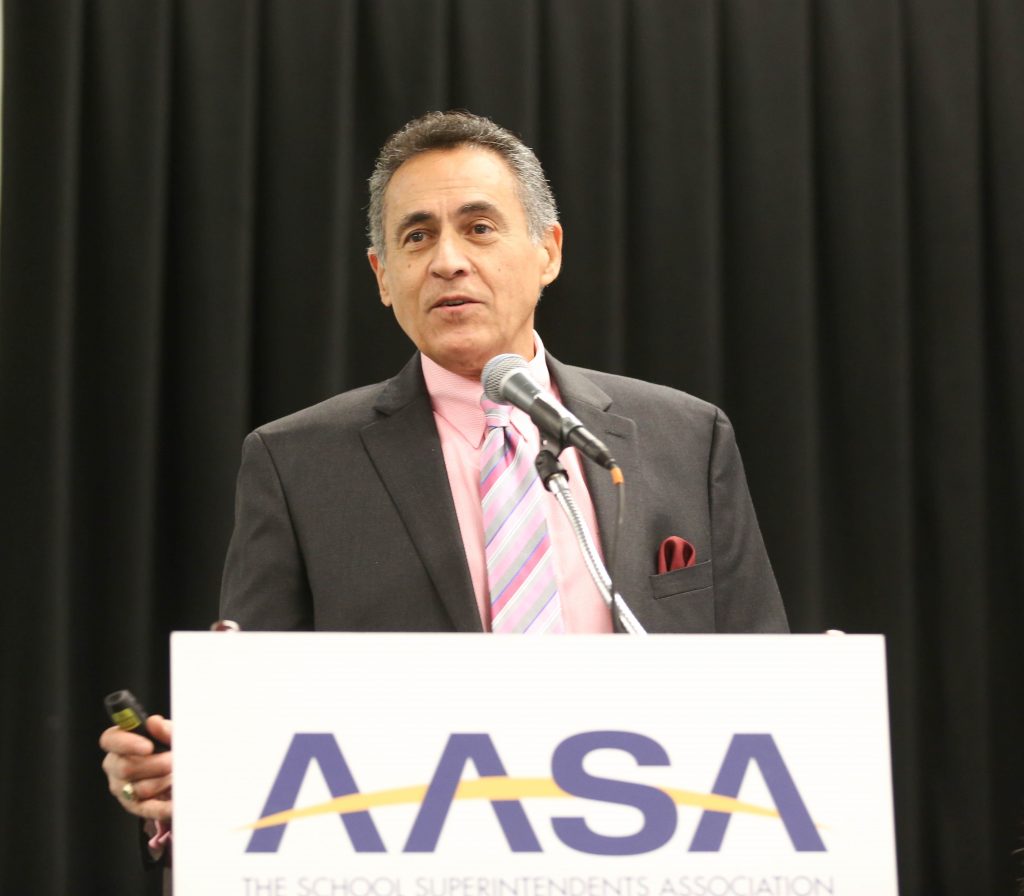Calling it “an active and productive year,” AASA Executive Director Dan Domenech recounted the national organization’s vitality both programmatically and fiscally, sharing plenty of evidence during his half-hour presentation at Wednesday’s Governing Board meeting.
Before about 100 members of the association’s governing forum, Domenech delivered plenty of reasons to show how the 153-year-old professional group has adjusted to the times to effectively and nimbly serve its members in a fast-changing environment for public schools, where there are plenty of detractors today.
The Governing Board took several actions as well. The members adopted a modified mission statement for the organization that makes equity for students a primary goal and ratified a membership dues increase that will range from $2 to $10 a year depending on the membership category.
The Governing Board also formally approved the slate of three candidates who are vying for the AASA presidency and a detailed legislative agenda outlined by the association’s head of public policy, Noelle Ellerson Ng.
AASA President Gail Pletnick presided over the daylong meeting at the Music City Center in Nashville, site of AASA’s three-day national conference.
Here’s a rundown of the key points Domenech delivered in his state-of-the-association address.
Conference Attendance. He said attendance in Nashville this week would clear 2,200, the conference’s highest level in at least 10 years. The total participant count, including exhibitors and spouses, would be close to 3,000. The level of corporate sponsorships and the number of exhibitors in Nashville also exceeded budgetary expectations.
AASA’s Public Campaign. Domenech pointed to the energy of AASA’s “I Love Public Education” campaign, noting that the demand for T-shirts had left staff members scrambling to fill orders for quantities of 100 or more. He called the campaign, which launched last summer and will include a public rally Friday morning at the conference, “a very positive movement, not defensive. Public education is the best it’s ever been. We don’t need to make public education great again.”
Hurricane Relief. The association distributed $118,000 of its own funds and another $20,000 in contributions to 29 districts in Texas, 10 districts in Florida and school systems in Puerto Rico and the Virgin Islands in the aftermath of natural disasters, especially destructive hurricanes last fall. He noted that Governing Board member Joseph Erardi now coordinates AASA’s rapid response to support members when dealing with emergencies such as student suicides or overdose deaths, student loss of life in vehicle accidents and fatal shootings.
Engagement. More than 2,000 superintendents and aspiring superintendents participated in the past year in AASA professional cohorts or certification programs. More than 30 AASA programs are in place for school system leaders. Corporate partners underwrite these programs significantly, he said, and make them affordable to the participants. NJPA is AASA’s biggest corporate benefactor.

Membership. While other professional educator groups are seeing declines, AASA’s membership is holding steady, Domenech said. The challenge, he added, is keeping pace with superintendents leaving the field. In the past year, AASA attracted 1,500 new members. “We gain 100 but lose 95,” he quipped.
Dues Increase. The slight dues increase adopted by the Governance Board will bring in an extra $60,000 in revenue, which Domenech said would be applied to collaborative programs with state associations. He expected a monetary incentive to be offered to state affiliates that increase the number of their members who join AASA. He also anticipates more joint training programs for aspiring superintendents, expanding on the programs that AASA now operates with its affiliates in Minnesota, Mississippi and West Virginia.
Balanced Budget. AASA finished the past fiscal year with a $700,000 surplus in its operating budget. Much of that surplus was invested in AASA’s “I Love Public Education” campaign and in hurricane relief efforts in school districts affected. He said AASA’s full-time staff size has grown modestly during his tenure as director to 40 staff members today. “We have a small but effective and efficient staff,” he said.
Advocacy Work. The director credited the work of AASA’s three-member public policy team for its advocacy work before Congress during the past year. He noted their work often carried beyond education to address health needs of young people and federal tax reform. Acknowledging that 50 percent of school districts enrolled 1,000 or fewer students, he talked about AASA assuming management oversight of the Rural Schools and Community Trust, whose director has moved into AASA headquarters.
Children’s Programs. He lauded AASA’s Children’s Programs Department for enabling the association to “walk the talk” through its initiatives, funded by outside sources, to support school breakfast programs and federally funded health insurance for low-income children. Domenech pointed to two newly funded initiatives – $225,000 for a partnership with Stand for Children on a middle school kindness program and $100,000 in funding from Communities in Schools.
(Jay P. Goldman is editor of AASA’s Conference Daily Online.)

